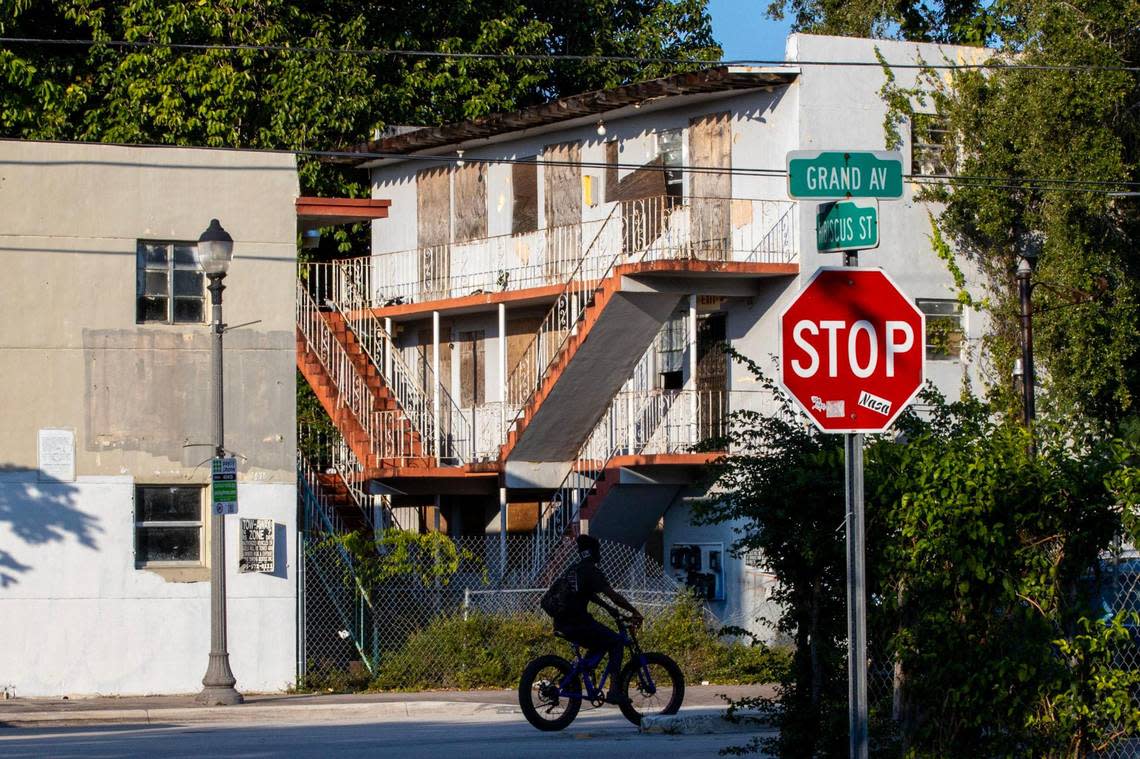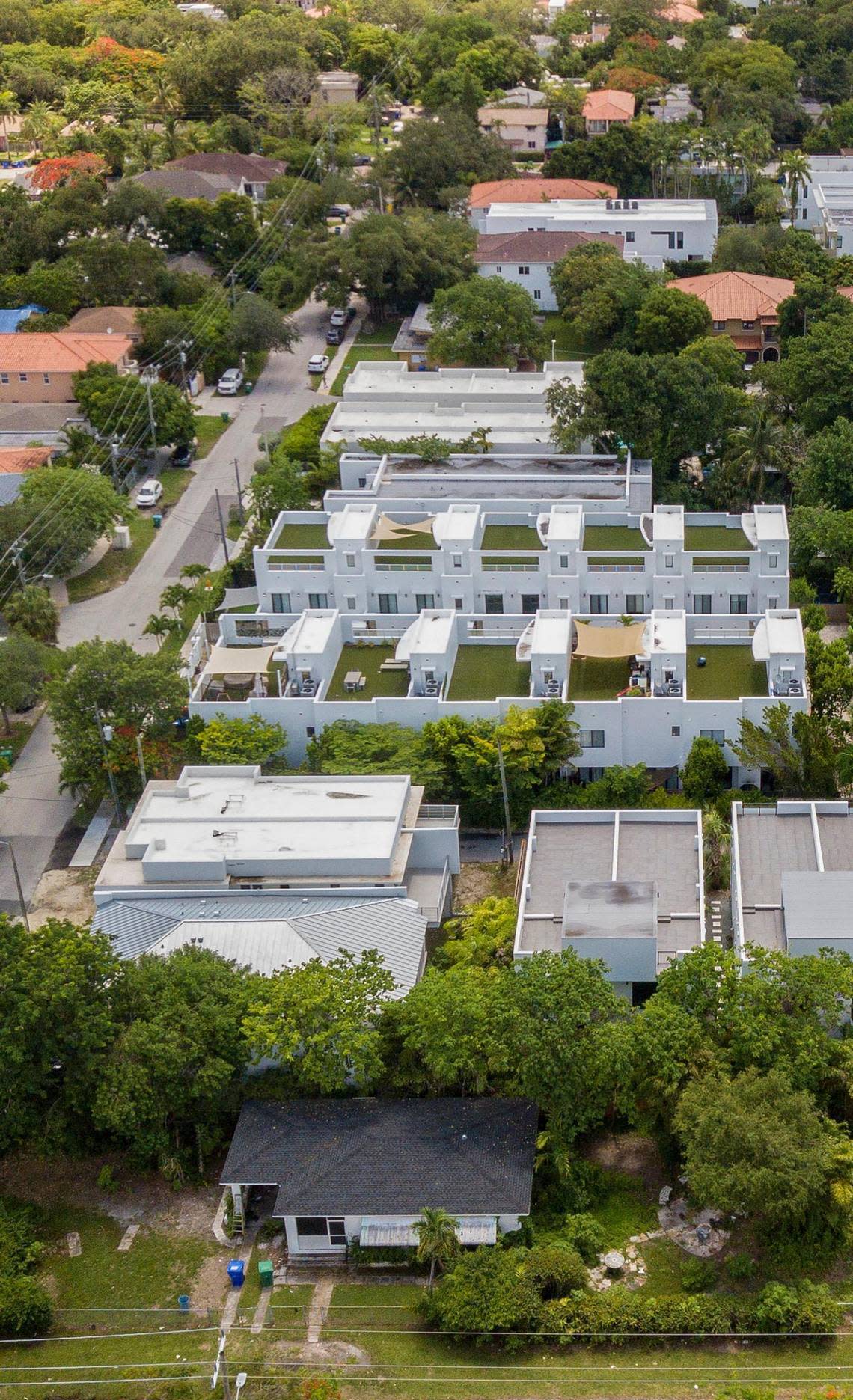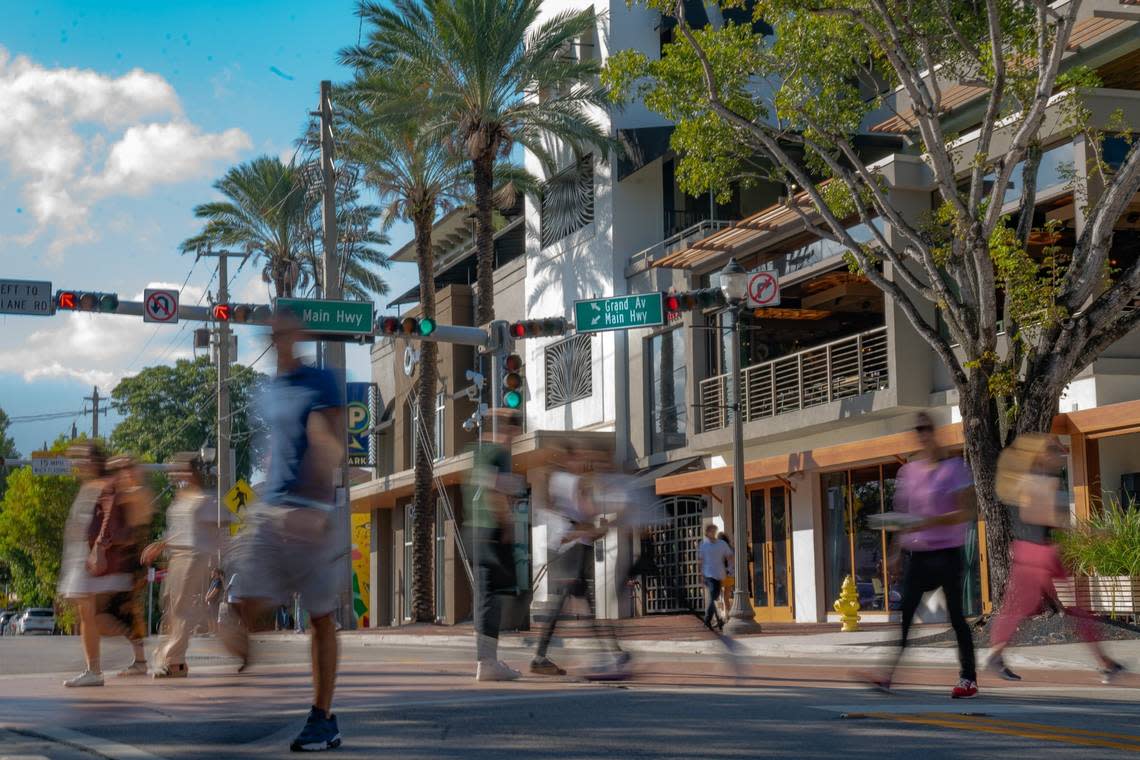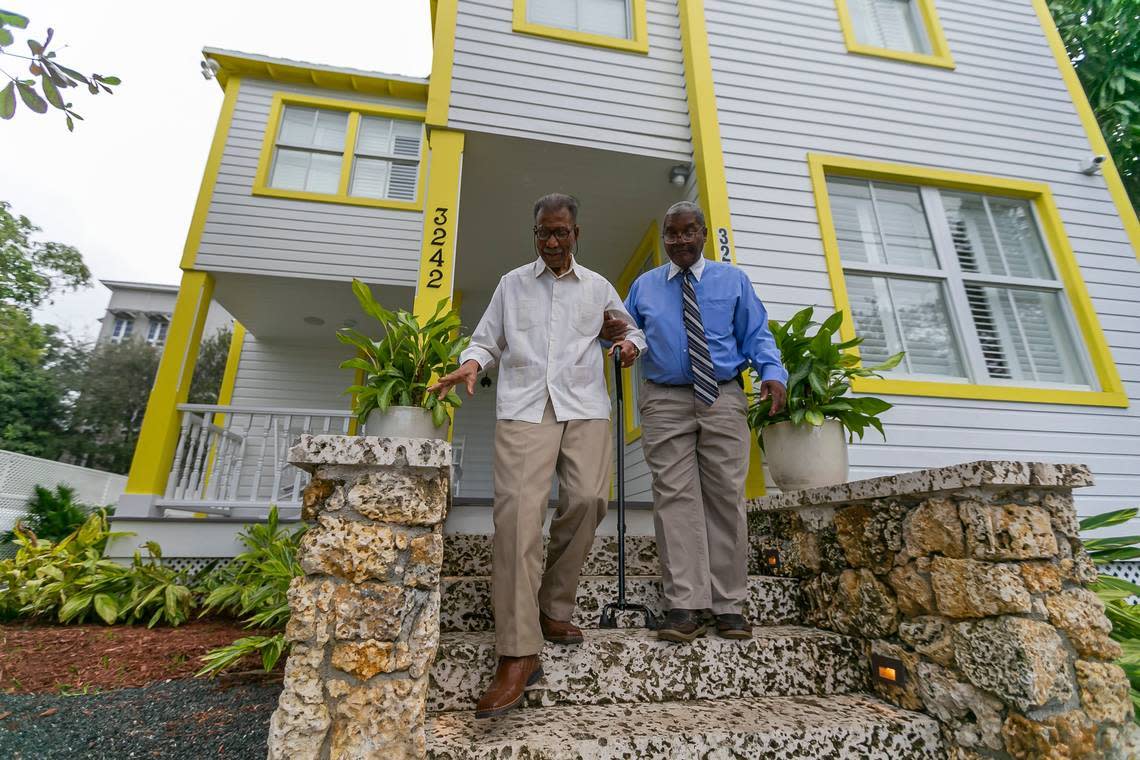Broken Promises: Miami’s erasing its Black history one bungalow at a time. Who will stop it? | Opinion
Miami needs to take a hard look at Grand Avenue in western Coconut Grove — and then a hard look in the mirror. An important piece of Miami’s Black history is being erased before our eyes. And there’s no real drive to stop it.
Grand Avenue was once the vital economic engine of this historically Black neighborhood. It’s now mostly shuttered stores and empty lots, gutted by a combination of broken redevelopment promises and decades-long neglect, official and unofficial.
We’ve written about those failures time and again. But as Grand Avenue declines, there’s a more insidious loss happening, too: the slow but effective blotting out of the physical traces of the largely Bahamian community that settled the West Grove before Miami was a city and helped carve it from coral bedrock as far back as the 1880s.
Those settlers and the African-American residents who joined them helped make Miami — literally. But neglect, disinvestment and, now, accelerating gentrification through a newly aggressive style of real-estate investing are all but wiping out the evidence of those foundational contributions.
Just this year, a plan to create a community redevelopment agency to help revitalize the area was discarded, perhaps with good reason. But where does that leave us? Adding another washed-out idea to the pile of initiatives that have come to nothing. In turn, the remnants of the old West Grove become more vulnerable than ever to that convenient scapegoat, “market forces.”

By rights, an alarm should be sounding on Grand Avenue, a horn blaring to warn of its imminent demise. What’s happening there, in the broader West Grove — and in other places, too, such as Little Haiti and Overtown — amounts to allowing the extinction of something important. We’re failing to preserve our multicultural past. We’re giving an “oh-well” shrug as entire groups of people are being removed from the narrative of South Florida.
That cannot be the final word. We can’t let it be. There are still pieces of the Black Grove to preserve for future generations. And there are still efforts being made to stabilize the community. The county’s push to increase housing density near mass transit hubs is one of them. Individual programs, though, won’t be enough.
Pulling what’s left of the original West Grove back from the brink, if it can be done, will take the combined efforts of the county, city and the neighborhood. It’ll require cooperation, and someone will need to take a leading role. We suggest whomever replaces outgoing Miami City Commissioner Ken Russell, whose district includes the Grove.
Miami Mayor Francis Suarez, too, should weigh in. We were disappointed when he failed to speak out against a City Commission plan to redraw its political boundary lines that waters down Blacks’ voting power in the Grove. But he did help hit pause on Commissioner Joe Carollo’s misbegotten proposal to place scores of tiny homes for the homeless on Virginia Key, another site of significance in the city’s Black past. So maybe he can find his voice now to decry the slow-motion destruction of the historic Black Grove.
Losing a street, or even a neighborhood, may not seem like much — change is inevitable, and Miami is a city of relentless reinvention — but Grand Avenue and its surroundings are tied to the very founding of the city and shouldn’t be cast aside so easily. The West Grove is where Bahamian immigrants built homes nearly 150 years ago, its residents providing a workforce to help build the nascent city and even some of the required signatures for Miami’s 1896 incorporation. That is not unimportant. In other cities, with a deeper sense of history and civic pride, it would be celebrated, not ignored.

Miami has a memory problem, though. We can barely remember the promises made last year, let alone decades ago. Developers and politicians have counted on that for years, with Grand Avenue as just one more example. If Miami’s leaders have any hope of saving even the last bits of the Black Grove, they need to act now.
Center of commerce
The West Grove was once a thriving community, a beacon for the Black working and middle class, drawing African Americans from North Florida and the deep South, especially after World War II. Grand Avenue, the Jim Crow-era dividing line between white Grove and Black — one that still persists in some ways — was a bustling center of commerce.
Generational housing turnover, poverty and neglect — with economic and institutional racism no doubt playing a big role — took a toll in the ensuing years, and parts of the tight-knit community with its shotgun homes and spreading tree canopy became increasingly run down. Effort after effort to inject new life into the area and especially into Grand Avenue has flared, sputtered and died.
As time rolls on, there is less left to preserve, a cycle that plays conveniently into the hands of profit-minded developers blind to everything but the prime location and relatively cheap housing costs, the twin drivers of Florida’s existence.
Today, gentrification is everywhere. Modern, white-box houses, derided by some as soulless “sugar cubes,” are creeping from the affluent eastern Grove toward the west. Longtime residents are forced out, age out or sell, unable or unwilling to turn down high-priced offers for small homes that then become knockdowns.
Lack of political power in the area, no cohesive effort by government, a willingness to surrender to those eager to make a buck, the scourge of racism — they all have played a role in this dismaying tale, as the Miami Herald reported in a recent series, On the Brink.
Marvin Dunn, a noted Miami historian who grew up in the West Grove, said outside forces, including the 1980 race riots that spread to the Grove, contributed to Grand Avenue’s failure to flourish. But he said family ties to the neighborhood have also frayed over the decades.
“The families that were originally in those homes in the Grove, the pioneers and the next generation of Blacks who were in the West Grove, those folks I don’t think would have thought about selling their homes. They were attached to the land. But now we’re three or four generations away from the original Black Grove families, and those lots are very, very valuable and these folks are selling them off.”
In the end, he said, “I think you’re going to see the gentrification march right down Grand Avenue.”
Plans lead nowhere
Three decades of plans and promises have produced little progress in the West Grove, as Grand Avenue’s past continues to wither. There was the 1980 proposal to turn the street into a business district with a Bahamian theme and a 1984 plan for a “Goombay Plaza” with an outdoor market. In 1986, there was an affordable-housing idea, complete with celebrity architects, that took way too long to complete and wound up with units way too expensive for the intended residents. There was a “slum clearance” plan to relocate 99 families and a “Grand Avenue Vision Plan.”

Just last year, there was a misplaced effort along Grand Avenue to build a Wawa, the ubiquitous gas station and sandwich shop chain, in a spot that was originally planned for affordable housing. The outcry that followed doomed it. That may have been for the best, but it left the land, once again, vacant.
Perhaps more significant from a revitalization perspective, there was last year’s proposal to create a community redevelopment agency to help pay for affordable housing, an effort to help stabilize the community. City Commissioner Russell had long championed the idea, but it failed to secure a necessary approval this year from the County Commission.
Other ideas to help the West Grove have been floated, including focusing on the county’s existing plan to increase housing density near transit stations, with a certain amount of affordable housing included. It’s hard to see that sort of thing working quickly enough to make a difference. The people building those sugar-cube houses aren’t likely to respect drawn-out government time lines.
If the West Grove didn’t have enough problems, it will also now be suffering under a City Commission redistricting plan, approved earlier this year, that splits the historic neighborhood into three districts, with some Black residents ending up in a mostly Hispanic district. It was a move that smacked of diluting the strength of the Black vote, especially as it fights gentrification. Grove residents, long among the city’s most politically engaged, mounted a campaign against redistricting, but the city approved the new boundaries anyway. A lawsuit filed this month by the American Civil Liberties Union is challenging the maps in federal court on the grounds of “racial gerrymandering.”
Grassroots efforts
The West Grove isn’t lost just yet. There are small pockets of resistance to the economic pressures, groups like Rebuilding Together Miami-Dade, making repairs to dozens of homes that house longtime, elderly and low-income local residents. Others are working to preserve the distinct character of the neighborhood. The 1897 E.W.F. Stirrup House has been painstakingly rebuilt by descendants of Bahamian-born pioneer settler Ebenezer Stirrup and is now an inn. There’s also talk of reopening the Jim Crow-era ACE movie theater on Grand. Perhaps that could spark redevelopment the way the Lyric Theater has in Overtown, another historically Black Miami neighborhood in danger of being gentrified out of existence. The famed Goombay Festival, an annual celebration of West Grove’s Bahamian roots that once drew thousands, was revived this year in a smaller version.

Additional traces of the old Grove will remain — 20 or 30 of the early cottages are being saved through historic designation, Dunn said — but the bulk of the fight may already be over. “In 10 years,” he said, “we won’t be able to recognize what we now call the West Grove or the Black Grove.”
That doesn’t have to happen, or at least not completely. It took citizens banding together to save Art Deco buildings in Miami Beach from developers, buildings that were derided at the time as unimportant, outdated relics. All the buildings weren’t saved but a lot were. Today the Deco district is a worldwide draw for tourists.
There are economic forces at play in the case of the Grove that no one could, or even should, stop. We are not anti-capitalism. But rolling over isn’t the answer, either. A new and concerted effort by the county, the city and West Grove residents is needed to set up a framework to preserve at least some part of what makes the West Grove special.
Grand Avenue and the West Grove represent something deeply important and worth saving. They’re a callback to old Florida and, particularly, a part of Florida that Black people built in the face of persistent racism. If we allow these tangible reminders to be bulldozed away, we will be compounding the indignities imposed on generations of Black residents.
Losing Grand Avenue and the West Grove doesn’t just erase history. It diminishes us all.
